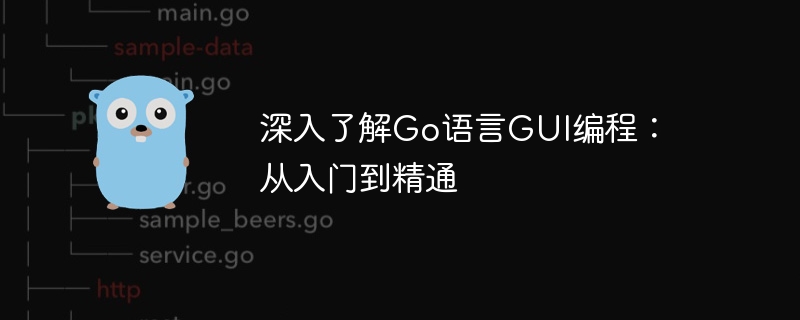Home >Backend Development >Golang >In-depth understanding of Go language GUI programming: from entry to mastery
In-depth understanding of Go language GUI programming: from entry to mastery
- WBOYWBOYWBOYWBOYWBOYWBOYWBOYWBOYWBOYWBOYWBOYWBOYWBOriginal
- 2024-03-24 21:06:041543browse

In today's software development field, GUI (Graphical User Interface, graphical user interface) programming is a crucial part. It allows users to interact with programs intuitively, improving user experience and making programs easier to use. Among many programming languages, Go language, as a language that has attracted much attention in recent years, also has the ability of GUI programming. This article will give you an in-depth understanding of Go language GUI programming from entry to proficiency, and help you better master this skill through specific code examples.
Part One: Introduction to Go Language GUI Programming
To do Go language GUI programming, you first need to make it clear: the Go language itself does not provide an official GUI library, but there are many community-developed libraries. Third-party GUI libraries are available. In this article, we will use fyne and walk as examples to introduce Go language GUI programming.
1.1 Introduction to fyne
fyne is a lightweight, modern Go language GUI toolkit that can help you quickly build cross-platform GUI applications. Using fyne, you can create beautiful interfaces, and it provides a simple and easy-to-use API interface. Next, we will use a simple example to show how to use fyne to create a basic GUI application.
package main
import (
"fyne.io/fyne/v2/app"
"fyne.io/fyne/v2/container"
"fyne.io/fyne/v2/widget"
)
func main() {
myApp := app.New()
myWindow := myApp.NewWindow("Hello")
myWindow.SetContent(container.NewVBox(
widget.NewLabel("Hello, World!"),
))
myWindow.ShowAndRun()
}The above code creates a simple GUI application with a "Hello, World!" label displayed in the window. You can see the effect by installing the fyne library and running the code.
1.2 Introduction to walk
walk is another commonly used Go language GUI library. It provides rich controls and functions and supports the Windows platform. Compared with fyne, walk is more inclined to the traditional GUI development method and requires a deeper understanding to use it. Here is a simple example of using walk to create a GUI application:
package main
import (
"github.com/lxn/walk"
)
func main() {
mw, _ := walk.NewMainWindow()
label, _ := walk.NewLabel(mw)
label.SetText("Hello, World!")
mw.SetTitle("Hello")
mw.SetLayout(walk.NewVBoxLayout())
mw.SetFixedSize(walk.Size{Width: 200, Height: 100})
mw.Run()
}In the above example, we created a window and added a label to the window that displays "Hello, World!". You can also see the effect of your GUI application by installing the walk library and running the code.
Part 2: Advanced Go Language GUI Programming
Once we have mastered the basic GUI programming knowledge, we can further learn some advanced techniques and functions. In this section, we will explore some common GUI programming concepts and demonstrate them with code examples.
2.1 Event Handling
In GUI applications, event handling is a crucial part. User interaction will trigger different events, and we need to write corresponding processing code to respond to these events. Here is a simple example that demonstrates how to handle button click events in fyne:
package main
import (
"fyne.io/fyne/v2/app"
"fyne.io/fyne/v2/container"
"fyne.io/fyne/v2/widget"
)
func main() {
myApp := app.New()
myWindow := myApp.NewWindow("Button Click Example")
button := widget.NewButton("Click Me", func() {
widget.NewLabel("Button Clicked!").Show()
})
myWindow.SetContent(container.NewVBox(
button,
))
myWindow.ShowAndRun()
}In the above example, we have created a button that will pop up a prompt when the user clicks the button. In this way, we can flexibly handle different user events and improve the interactivity of the application.
2.2 Layout Management
Good layout is the key to the success of a GUI application. In Go language GUI programming, we can use different layout managers to achieve various layout effects. For example, fyne provides a variety of layout managers, such as VBox, HBox, Grid, etc., which can help us arrange controls flexibly. The following is an example of using Grid layout:
package main
import (
"fyne.io/fyne/v2/app"
"fyne.io/fyne/v2/container"
"fyne.io/fyne/v2/widget"
)
func main() {
myApp := app.New()
entry := widget.NewEntry()
button := widget.NewButton("Submit", func() {
widget.NewLabel("Text entered: " + entry.Text).Show()
})
grid := container.New(layout.NewGridLayout(2),
widget.NewLabel("Enter Text:"),
entry,
widget.NewLabel(""),
button,
)
myWindow := myApp.NewWindow("Grid Layout Example")
myWindow.SetContent(grid)
myWindow.ShowAndRun()
}By using Grid layout, we can arrange controls in rows and columns to achieve a neater interface layout.
Conclusion
Through the introduction and examples of this article, I believe you already have a certain understanding of Go language GUI programming. Although GUI programming has a certain complexity, as long as you master the basic knowledge and skills, you can easily create beautiful and practical GUI applications. I hope this article can help you better master Go language GUI programming and enjoy the fun of programming!
The above is the detailed content of In-depth understanding of Go language GUI programming: from entry to mastery. For more information, please follow other related articles on the PHP Chinese website!

